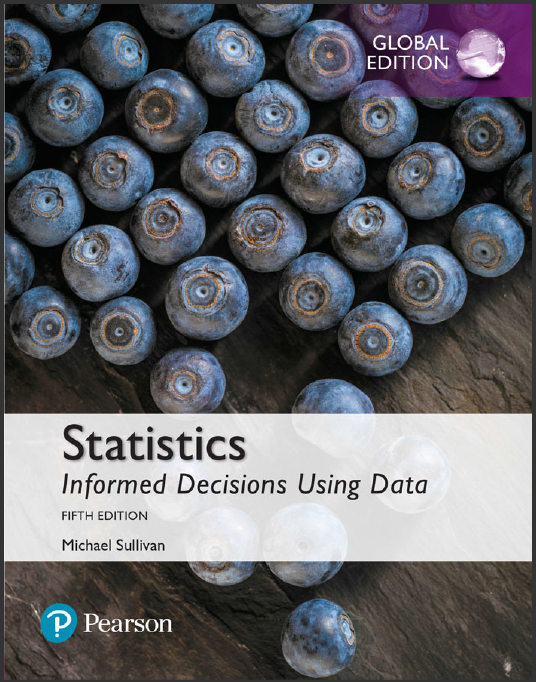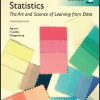Test Bank for Statistics Informed Decisions Using Data 5th Edition by Michael Sullivan 1292157119 9781292157115
$70.00 Original price was: $70.00.$35.00Current price is: $35.00.
Instant download (Test Bank) Statistics Informed Decisions Using Data 5th Global Edition after payment
Test Bank for Statistics Informed Decisions Using Data 5th Edition by Michael Sullivan – Ebook PDF Instant Download/Delivery: 1292157119,9781292157115
Full dowload Statistics Informed Decisions Using Data 5th Global Edition after payment

Product details:
ISBN 10: 1292157119
ISBN 13: 978-1292157115
Author: Michael Sullivan
Statistics: Informed Decisions Using Dat, gives students the tools to see a bigger picture and make informed choices. As a current introductory statistics instructor, Mike Sullivan III presents a text that is filled with ideas and strategies that work in today’s classroom. His practical emphasis resonates with students and helps them see that statistics is connected, not only to individual concepts, but also with the world at large.
The full text downloaded to your computer
With eBooks you can:
- search for key concepts, words and phrases
- make highlights and notes as you study
- share your notes with friends
eBooks are downloaded to your computer and accessible either offline through the Bookshelf (available as a free download), available online and also via the iPad and Android apps.
Upon purchase, you will receive via email the code and instructions on how to access this product.
Statistics Informed Decisions Using Data 5th table of content:
Part 1: Getting the Information You Need
Chapter 1: Data Collection
1.1 Introduction to the Practice of Statistics
1.2 Observational Studies versus Designed Experiments
1.3 Simple Random Sampling
1.4 Other Effective Sampling Methods
1.5 Bias in Sampling
1.6 The Design of Experiments
Part 2: Descriptive Statistics
Chapter 2: Organizing and Summarizing Data
2.1 Organizing Qualitative Data
2.2 Organizing Quantitative Data: The Popular Displays
2.3 Additional Displays of Quantitative Data
2.4 Graphical Misrepresentations of Data
Chapter 3: Numerically Summarizing Data
3.1 Measures of Central Tendency
3.2 Measures of Dispersion
3.3 Measures of Central Tendency and Dispersion from Grouped Data
3.4 Measures of Position and Outliers
3.5 The Five-Number Summary and Boxplots
Chapter 4: Describing the Relation between Two Variables
4.1 Scatter Diagrams and Correlation
4.2 Least-Squares Regression
4.3 Diagnostics on the Least-Squares Regression Line
4.4 Contingency Tables and Association
Part 3: Probability and Probability Distributions
Chapter 5: Probability
5.1 Probability Rules
5.2 The Addition Rule and Complements
5.3 Independence and the Multiplication Rule
5.4 Conditional Probability and the General Multiplication Rule
5.5 Counting Techniques
5.6 Putting It Together: Which Method Do I Use?
Chapter 6: Discrete Probability Distributions
6.1 Discrete Random Variables
6.2 The Binomial Probability Distribution
6.3 The Poisson Probability Distribution
Chapter 7: The Normal Probability Distribution
7.1 Properties of the Normal Distribution
7.2 Applications of the Normal Distribution
7.3 Assessing Normality
7.4 The Normal Approximation to the Binomial Probability Distribution
Part 4: Inference: From Samples to Population
Chapter 8: Sampling Distributions
8.1 Distribution of the Sample Mean
8.2 Distribution of the Sample Proportion
Chapter 9: Estimating the Value of a Parameter
9.1 Estimating a Population Proportion
9.2 Estimating a Population Mean
9.3 Estimating a Population Standard Deviation
9.4 Putting It Together: Which Procedure Do I Use?
9.5 Estimating with Bootstrapping
Chapter 10: Hypothesis Tests Regarding a Parameter
10.1 The Language of Hypothesis Testing
10.2 Hypothesis Tests for a Population Proportion
10.3 Hypothesis Tests for a Population Mean
10.4 Hypothesis Tests for a Population Standard Deviation
10.5 Putting It Together: Which Method Do I Use?
10.6 The Probability of a Type II Error and the Power of the Test
Chapter 11: Inferences on Two Samples
11.1 Inference about Two Population Proportions
11.2 Inference about Two Means: Dependent Samples
11.3 Inference about Two Means: Independent Samples
11.4 Inference about Two Population Standard Deviations
11.5 Putting It Together: Which Method Do I Use?
Chapter 12: Inference on Categorical Data
12.1 Goodness-of-Fit Test
12.2 Tests for Independence and the Homogeneity of Proportions
12.3 Inference about Two Population Proportions: Dependent Samples
Chapter 13: Comparing Three or More Means
13.1 Comparing Three or More Means (One-Way Analysis of Variance)
13.2 Post Hoc Tests on One-Way Analysis of Variance
13.3 The Randomized Complete Block Design
13.4 Two-Way Analysis of Variance
Chapter 14: Inference on the Least-Squares Regression Model and Multiple Regression
14.1 Testing the Significance of the Least-Squares Regression Model
14.2 Confidence and Prediction Intervals
14.3 Introduction to Multiple Regression
14.4 Interaction and Dummy Variables
14.5 Polynomial Regression
14.6 Building a Regression Model
Chapter 15: Nonparametric Statistics
15.1 An Overview of Nonparametric Statistics
15.2 Runs Test for Randomness
15.3 Inference about Measures of Central Tendency
15.4 Inference about the Difference between Two Medians: Dependent Samples
15.5 Inference about the Difference between Two Medians: Independent Samples
15.6 Spearman’s Rank-Correlation Test
15.7 Kruskal–Wallis Test
People also search for Statistics Informed Decisions Using Data 5th:
statistics informed decisions using data 6th edition answers
statistics informed decisions using data 5th edition
statistics test bank questions and answers
statistics informed decisions using data with integrated review


